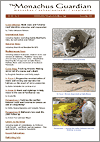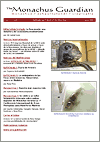Monachus Guardian 2009 in Spanish
Thanks to the support of the Government of the Balearic Islands, and the translation efforts of Toni Font, the June and November 2009 issues of The Monachus Guardian have now been published in Spanish.
If you have Spanish-language friends or colleagues who might be interested in the publication, please let them know.
The Spanish translation can be accessed at www.monachus-guardian.org/spanish or through the TMG portal www.monachus-guardian.org.
Monachus Guardian news blog
The Monachus Guardian news blog continues to deliver breaking news updates between the summer and winter issues of the journal.
If you have monk seal-related news, images or video you would like to submit for publication, please contact the
.
Publications Watch
We take the opportunity of alerting our readers to the following publications, on monk seal, marine biodiversity or broader conservation issues.
King, Judith E. 1956. The Monk Seals (Genus Monachus). Bulletin of the British Museum (Natural History – Zoology) London 3: 201-256, 8 pls.
Judith King’s landmark 1956 review of the Genus Monachus has been republished online by Biostor via the Biodiversity Heritage Library. The publication is also available as a PDF or text file download. [PDF  16.2MB] 16.2MB]
Fulton, Tara L. and Curtis Strobeck. 2010. Multiple fossil calibrations, nuclear loci and mitochondrial genomes provide new insight into biogeography and divergence timing for true seals (Phocidae, Pinnipedia). Journal of Biogeography 37(5): 814-829. DOI: 10.1111/j.1365-2699.2010.02271.x [Abstract]
A new publication on the historical biogeography of the true seals, employing genetic analysis of fossil samples. In their main conclusions, the authors state: “Incorporating multiple nuclear genes and fossil calibrations had a profound effect on the estimated divergence times. Most estimated divergences within Phocinae (Arctic seals) correspond to Arctic oceanic events and all occur within the last 12 Myr, a time when the Arctic and Atlantic oceans were freely exchanging and perennial Arctic sea ice existed, indicating that the Arctic seals may have had a longer association with ice than previously thought. The Monachinae ('southern' seals) split from the Phocinae c. 15 Ma on the eastern US coast. Several early trans-Atlantic dispersals possibly occurred, leaving no living descendants, as divergence estimates suggest that the Monachus (monk seal) species divergences occurred in the western Atlantic c. 6 Ma, with the Mediterranean monk seal ancestor dispersing afterwards. The tribes Lobodontini (Antarctic seals) and Miroungini (elephant seals) are also estimated to have diverged in the eastern Atlantic c. 7 Ma and a single Lobodontini dispersal to Antarctica occurred shortly afterwards. Many of the newly estimated dates are used to infer how extinct lineages/taxa are allied with their living relatives.”

IUCN. 2010. 2010: Mediterranean Biodiversity – Our Life, Centro de Cooperación del Mediterráneo de UICN, Málaga, Spain: 1-26. [PDF  470KB] 470KB]
A 2010 calendar marking and celebrating the International Year of Biodiversity. Devoting a page of facts and figures per month to Mediterranean biodiversity, IUCN brings its own characteristic slant to the issue, highlighting perceived threats and benefits to the reigning top of the food chain, Homo sapiens.
“Species provide us with essential services: not only food, fuel, clothes and medicine, but also purification of water and air, prevention of soil erosion, regulation of climate, pollination of crops by insects, and many more. In the Mediterranean, they provide a vital resource for the tourism and fishing industries, as well as having significant cultural, aesthetic and spiritual values. Consequently the loss of species diminishes the quality of our lives and our basic economic security. From an ethical point of view, species are part of our natural heritage and we owe it to future generations to preserve and protect them. […]
The Mediterranean is a densely populated region that receives large numbers of visitors each year, and direct disturbance by humans is an important threat to some animals and plants, including iconic Mediterranean species such as the Northern Bald Ibis Geronticus eremita and the Mediterranean Monk Seal Monachus monachus, both listed as Critically Endangered. Disturbance at breeding sites can be particularly problematic, as species may abandon their young.”
EPOCA. 2010. Ocean acidification: the facts. A special introductory guide for policy advisers and decision makers. European Project on Ocean Acidification: 1-12. [PDF  2.6MB] 2.6MB]
Climate change and ocean acidification pose serious threats to the marine environment, including Hawaiian and Mediterranean monk seals. Acidification is expected to result in plummeting fish stocks, while rising sea levels may deprive monk seals of vital resting, breeding and nursing habitat. In the Mediterranean, extreme weather events associated with global warming may increase the frequency and severity of storm surges into caves, especially during the critical autumn/winter birthing season.
This guide to the potential impacts of ocean acidification was prepared by the EU-funded European Project on Ocean Acidification, a consortium of 27 research institutes and environment agencies.
“This introductory guide is written especially for policy advisers and decision makers worldwide and is a wake-up call about the double impact on our seas of climate change and ocean acidification caused by increasing atmospheric carbon dioxide levels.[…] The Earth’s geological record shows that previous episodes of ocean acidification were linked to mass extinctions of some species, and it is reasonable to assume that this episode could have the same consequences. […] Ocean acidity has increased by 30% since the beginning of the Industrial Revolution and the rate of acidification will accelerate in the coming decades. This rate of change, to the best of our knowledge, is many times faster than anything previously experienced over the last 55 million years.”
EndQuote
Europe warns of critical species loss
The European Commission will warn next week that, alongside climate change, the loss of plant and animal species is “the most critical global environmental threat” to the planet.
More than 700 species, including the Iberian lynx and the Mediterranean monk seal, face possible extinction. Only one in six of the EU's protected habitats has a favourable conservation status as required by EU law. Grasslands, coastlands, bogs and fens have been in decline, although forest cover has increased. […]
“There is mounting evidence that the status of many ecosystems is reaching or has already reached the point of no return,” states the draft. “The loss of biodiversity beyond certain limits would have far-reaching consequences for the very functioning of the planet.”
Source: Commission paper warns of critical loss of species, Jennifer Rankin, European Voice, 14 January 2010.
|
|







